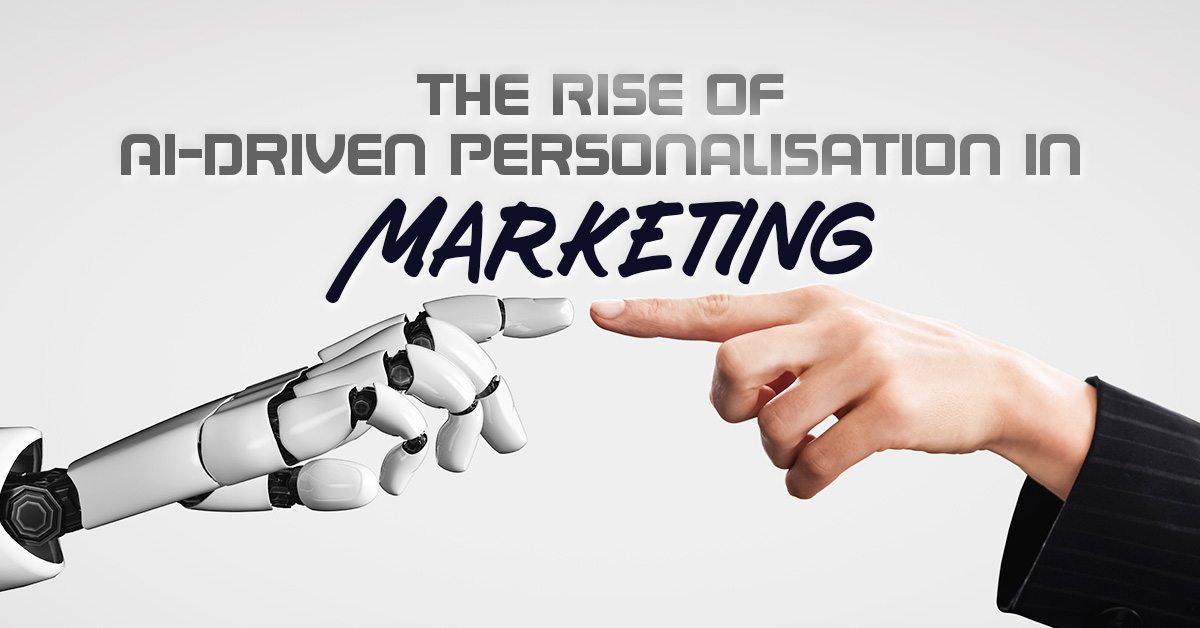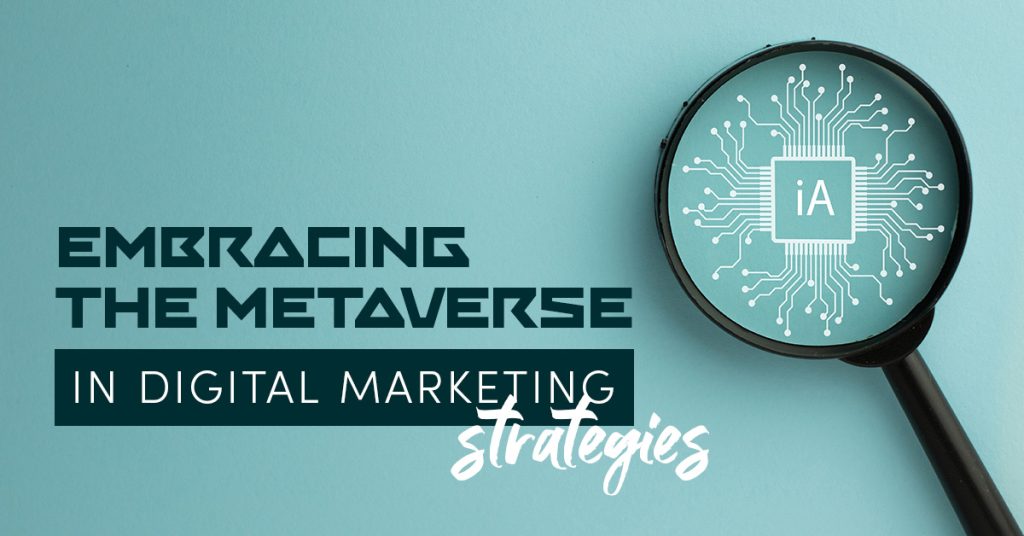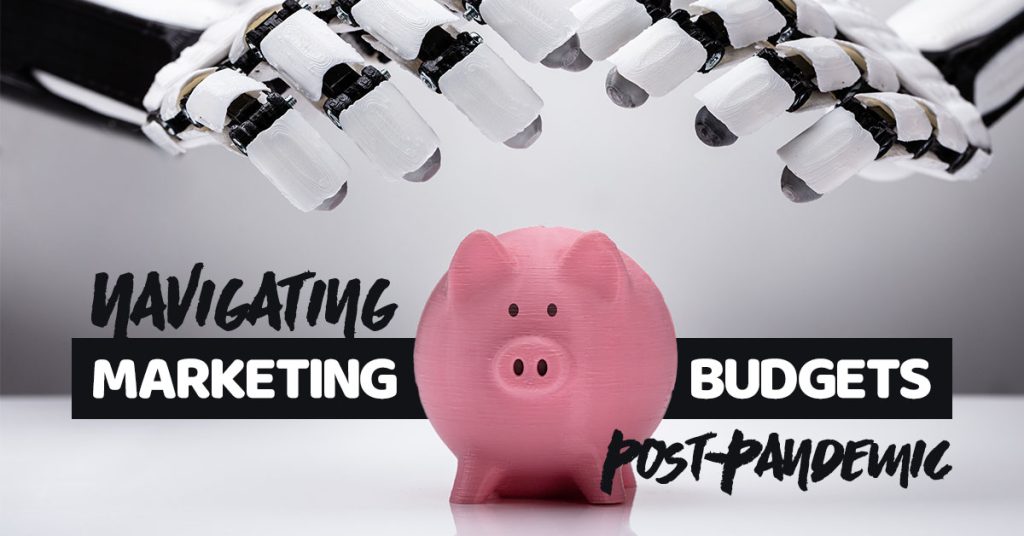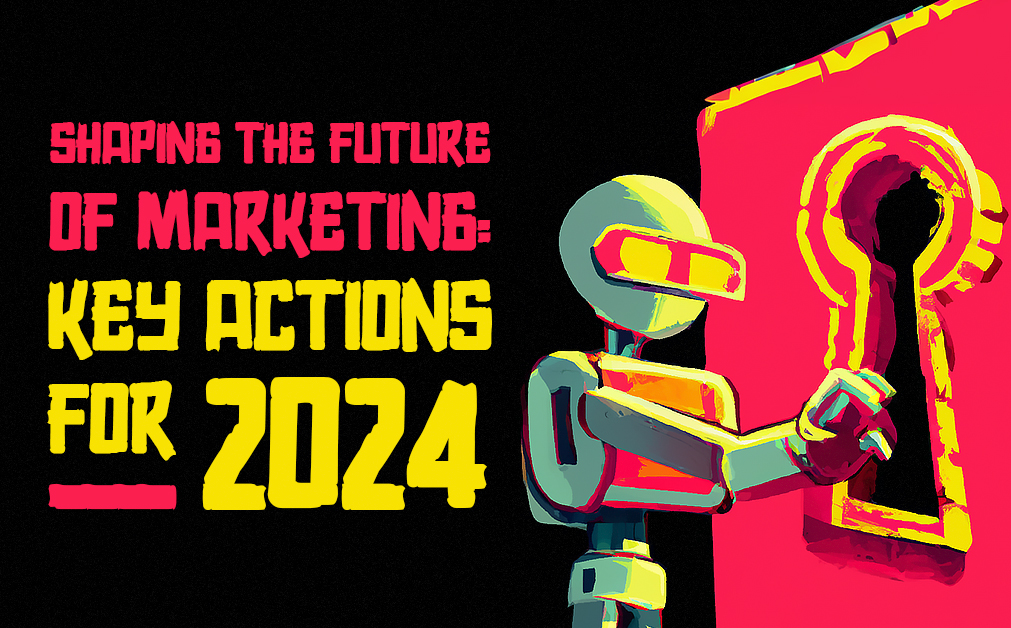Imagine you’re standing at the crossroads of a bustling digital marketplace. To your left, brands are chatting with customers like old friends, all thanks to AI that knows what they’ll want before even they do.
Take a right and there’s an entire universe where shopping feels like gaming – welcome to the metaverse! Now pause for a second; this isn’t some sci-fi daydream but rather snapshots from strategic marketing trends for 2024.
This tech revolution is something unprecedented; it’s not like any we’ve seen before. It weaves into our lives so seamlessly that we barely notice how algorithms subtly shape our desires. You might have dipped your toes in these waters already, maybe sent out an email campaign or two fine-tuned by machine learning or delved into Chat GPT to experiment with content creation for a blog or two.
But let’s dive in as I walk you through AI, data privacy, personalised ads and voice search as some of the major trends heading our way in 2024 – all the while making sure budgets post-pandemic don’t spiral out of control.


The Rise of AI-Driven Personalisation in Marketing
Imagine walking into a party and the host knows your favourite drink, the music you groove to, and who you’d hit it off with. That’s what artificial intelligence (AI) is doing for marketing—crafting experiences that feel like they were made just for you.
With AI-driven personalisation, brands can now greet you at the door with what you actually want, saving you from wading through an ocean of irrelevant options. This isn’t some pie-in-the-sky idea; AI marketing trends for 2024 predict this kind of brand engagement will revolutionise how we connect with businesses online.
Enhancing Customer Engagement with AI
Tapping into predictive analytics and sophisticated AI algorithms isn’t sci-fi anymore; it’s how brands are elevating their game to deliver personalised content that sings to each customer.
Sure, everyone likes being part of something big. But when Spotify says, ‘Here’s a playlist picked just for you,’ we listen because it feels personal—it speaks directly to us.
This approach is setting businesses apart because let’s face it: no one wants another generic email about ‘exciting offers’ clogging up their inbox.
Artificial Intelligence (AI) for personalisation isn’t only about knowing what customers want now but predicting what they’ll need next.
By analysing vast amounts of behavioural data—like browsing history or purchase patterns—brands anticipate needs before even the savviest shoppers do.
Dig this: Experts forecast an impressive transformation in brand engagement through AI-driven personalisation techniques—and first-party data is becoming king here. No more relying on third-party cookies that might crumble any minute now; businesses are getting smart by harnessing direct insights from users based on interactions with them alone.
Capitalising on Virtual Brand Experiences
Gone are the days when virtual reality (VR) was reserved only for gamers.
Today’s digital marketers use VR goggles as tools—to plunge people into immersive brand stories where every sight, sound, and sensation can be controlled to create unforgettable experiences.
Did someone say product launches? Think bigger. We’re talking full-on virtual worlds where consumers can test-drive cars without leaving home or try on clothes without undressing.
Imagine launching your latest product not in a physical store but within an immersive environment that spans continents without ever leaving home. The metaverse allows us to redefine ‘location’, taking our marketing landscape beyond brick-and-mortar constraints into something more than a traditional business strategy.
This shift towards emerging trends like augmented reality isn’t merely about keeping up with tech-savvy consumers; it’s also smart economics. Brands can save on overheads associated with physical events while potentially reaching broader audiences who are ready and willing to engage in new ways – think interactive product demos or live Q&A sessions with holographic reps.
This upward trajectory has stats suggesting our leap into these new realms could mean interacting with over 400 million users by 2030 in spaces worth northwards of $678 billion.
The growth of technology and digital platforms has revolutionised the way we conduct business, connect with others, and access information. It is essential to keep abreast of the most recent developments and adjust as necessary while we persist in taking advantage of these advances.
Key Takeaway
AI personalisation is like a party where everything is tailored to you, from tunes to drinks. Brands use AI to hit the right note with customers, creating bespoke experiences that resonate on a personal level.
Virtual reality isn’t just for gamers anymore; it’s helping brands create immersive worlds for product launches and trials, promising massive user engagement in the near future.


Embracing the Metaverse in Digital Marketing Strategies
The metaverse is not just a buzzword; it’s rapidly becoming a playground for digital marketing strategists.
Picture this: by 2030, the market value of this virtual universe could soar to an eye-watering $678.8 billion. And with over 400 million users possibly roaming these digital streets, the opportunity for brands is as vast as the virtual worlds themselves.
Strategic marketing trends for 2024 include tapping into these immersive platforms where people hang out virtually—maybe even more than IRL (in real life).
Brands need to get creative here because it’s one thing placing ads; another entirely creating engaging stories where avatars fall head-over-heels for products or services right there on Metaverse Avenue.
In these immersive realms, marketing isn’t just about plastering ads on billboards or interrupting experiences with pop-ups—it’s about creating moments and memories, a significant shift in marketing trends in 2024.
Voice Search Optimisation’s Role in Future Marketing Tactics
Voice search is no longer just a sci-fi fantasy. It’s completely altered the way we communicate with our technology.
We’ve all asked Siri, Alexa or Google Home for help at some point – which brings voice search optimisation centre stage when discussing future-proof strategies for any savvy business looking ahead into 2024.
To keep pace, we need our content production primed not only for screens but also ears—because optimising content goes hand-in-hand with how people actually speak (hint: long-tail keywords are your friend here).
By anticipating questions posed through smart speakers or built-in voice assistants across various devices, we’re enhancing customer engagement via convenience—an increasingly vital element amidst changing consumer preferences and behaviours.
Key Takeaway
Tap into the metaverse to create immersive brand experiences without physical limits. Save costs and reach a global audience with virtual events that turn sci-fi dreams into marketing reality.
Post-pandemic budget shifts mean we’ve got to spend smarter, not more—digital realms offer higher conversion rates and targeted advertising powered by sharp data analytics.
Voice search is huge; make sure your content’s ready for ears as well as eyes. Use natural language and long-tail keywords to boost engagement through smart devices everywhere.


Voice Search Optimisation’s Role in Future Marketing.
Imagine you’re shouting out for a pizza place while on the go. That’s voice search for you – swift, hands-free, and becoming everyone’s buddy. With smart speakers and voice assistants popping up in more homes, optimising your marketing content for this tech is not just clever; it’s crucial.
Why Voice Search Can’t Be Ignored
The chatter about digital marketing trends often skips over one silent giant: voice search optimisation.
But why should marketers tune into this trend?
Well, consider how we ask questions aloud – they’re longer and more conversational than typing into a search engine. This shift means long-tail keywords are taking centre stage because that’s how people actually speak.
To stay ahead of the curve, brands need to reframe their SEO strategies around natural language patterns used with devices like Alexa or Google Home. So as our chatty nature becomes part of searching online, businesses must adapt or risk falling behind in an increasingly vocal world.
Fine-Tuning Content for The Rise of Conversational Queries
Content production has always been about hitting the right notes with your target audience but now there’s a twist – it needs to BE GOOD too.
In other words, content should answer questions exactly as users would ask them out loud using voice search tools.
The art of optimising for voice search lies in understanding natural language processing—the tech behind these smart speakers’ brains. This isn’t about stuffing content with keywords; it’s about creating compelling responses to common questions people might be asking.
Think about providing direct answers within your content so when someone asks, ‘Where can I find red shoes near me?’, your site doesn’t just come back saying ‘red shoes’ but guides them straight to their local store options.
Or if someone asks, ‘Where can I get gluten-free bread?’ Your content should directly answer this. That means crafting content that’s not only relevant but chatty and personable too.
Incorporating structured data helps ensure those responses align perfectly with what consumers are asking their virtual assistants every day.
Leveraging Local Searches Through Voice Commands
Gone are days when ‘near me’ searches were only typed on keyboards after getting lost on streets.
Now customers shout queries from cars or kitchens looking for quick solutions nearby—think takeaway coffee spots or emergency plumbers. If you’ve got local services, then speaking directly (quite literally) to these potential clients via optimised listings could give conversions rates a nice boost.
Smart marketers responding to these emerging 2024 marketing trends, recognise that connecting locally through voice requires giving precise information like business hours and location details. Since many people use their mobile devices’ assistant features whilst multitasking or navigating through town—it’s all about delivering personalised experiences without making anyone stop what they’re doing.
The Impact of Smart Speakers on Shopping Habits
If we peek at recent stats showing increasing reliance on gadgets like Echo Dot, there lies an interesting opportunity: shopping via chatbots offering advice or even processing purchases.
This trend points towards a future where buying items could be as simple as having a quick chat with your smart device, blending convenience with technology seamlessly.
Key Takeaway
Optimising for voice search is now essential, not optional.
It’s all about long-tail keywords and conversational content that matches how we naturally speak to our smart devices. Get your content to provide direct answers for everyday questions, like guiding users to local red shoes rather than just stating “red shoes”.
Also, make sure your local listings are ready for a shout-out with up-to-date details.
Shopping? That’s changing too—voice-activated purchases are on the horizon.


Navigating Marketing Budgets Post-Pandemic
As we dust off the cobwebs from a post-pandemic world, it’s clear that marketing budgets have taken quite the hit.
Marketing Budget Concerns
Budget allocation has always been key, yet post-pandemic shifts have forced businesses large and small alike to reassess their spending habits—specifically within marketing departments where resources must align closely with consumer behaviour changes and technological advances.
Facts don’t lie: average marketing budgets now sit at around 9.1% of total company revenue—a dip from previous years’ allocations—but let’s see this as an invitation rather than a setback.
It nudges us toward smarter investments like those within digital realms where conversion rates often prove higher thanks to targeted ad placements based on first-party data analytics.
Allocating Resources for Maximum Impact
Let’s not beat around the bush: times are tough, and your marketing dollars need to work harder.
But how do you ensure your digital initiatives resonate in this brave new world?
You’ve got to align them with evolving consumer behaviours and technological advancements—that’s where the magic happens.
We’re talking about riding on the latest innovation while keeping a keen eye on what actually drives customer satisfaction—and ultimately sales.
This isn’t just throwing money at flashy ads; it’s about investing in areas like AI to build efficiencies, data privacy measures that build trust or programmatic advertising which places ads smarter, not harder.
The pandemic has taught us all one thing: expect the unexpected.
Digital marketing post-pandemic is no walk in the park. It requires a delicate balance between investing wisely and staying agile enough to pivot faster when consumer behaviour takes its next unpredictable turn.
Resourcing: Key Learnings
To make things easier for business owners, let me share some key learnings I’ve picked up along the way:
- Squeeze More Out Of Every Dollar: It might seem tempting to splash out vast amounts on broad ad placements hoping they stick—but why play do this blindfolded? Instead target audiences with laser precision using first-party data collected straight from your customers’ interactions with your brand.
- Create Authentic Connections: Consumers can smell insincerity a mile away —thanks to social media. So cut through by crafting genuine stories via content creation that resonates because people connect deeply with authenticity—not just another sales pitch dressed up in disguise.
- Harness AI For Smarter Content Production: Don’t shy away from generative AI tools; they’re your allies in producing captivating content on a large scale while maintaining high quality. These tools can process data quicker than ever before and spot trends well ahead of the curve. But do remember to run a skilled human touch over the content before just publishing. And like everything else out there, steer clear of free generative AI tools, as you pay for what you get.
Key Takeaway
Post-pandemic marketing demands more bang for your buck. Smart spending aligns with consumer shifts and tech advances, investing in trust-building privacy measures and savvy ad placements. Voice search optimisation is now key; so’s creating real connections through authentic content. Use AI tools to craft quality content quickly and spot trends early.
Conclusion
Think AI, think personalisation. That’s a cornerstone of strategic marketing trends for 2024.
It’s about harnessing first-party data to craft experiences that not just catch the eye but capture the heart.
Picture this: your brand thriving in the metaverse, an arena where engagement leaps off the charts and imagination rules supreme. Virtual worlds are no longer playthings; they’re places where business booms.
Budgets matter more than ever post-pandemic. Every dollar counts pushing marketers to pinpoint where spend reaps rewards amidst changing consumer habits and tech innovations.
Talk is cheap unless it’s voice search optimisation – then it turns into gold. In a world commanded by ‘Hey Google’ ‘Hey Siri’ and ‘Hi Alexa’, those who master this trend will find their brands spoken of often—and fondly.
Dive into these realms with excitement!
Let them shape strategies that resonate on a human level because, at its core, marketing is still about making authentic human connections through a well-crafted content strategy—even if it is in digital dimensions.
Get your FREE Marketing Check Up NOW!
Author: Stacy Farrell, Founder at Content Box
Assessment
Content Box Marketing Check Up
Answer a few questions about your marketing to see how you're doing. You'll get instant access to a detailed Check Up Report along with suggestions for improvement and marketing tips via email.
